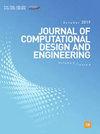增材制造驱动的热弹性结构拓扑和打印方向同步优化(考虑强度故障
IF 4.8
2区 工程技术
Q1 COMPUTER SCIENCE, INTERDISCIPLINARY APPLICATIONS
引用次数: 0
摘要
本文介绍了一种基于强度的同步优化方法,用于在增材制造引起各向异性的情况下优化热弹性结构拓扑和打印方向。该方法利用双向进化结构优化(BESO)框架,定义了包括元素密度和打印角度在内的设计变量。首先,建立了用于有限元分析的各向异性热弹性构成模型。通过引入蔡-希尔失效准则,制定了评估各向异性添加制造部件应力水平的强度约束。采用 P-norm 聚集函数来近似最大强度破坏系数。然后,通过拉格朗日乘法器将聚合强度约束增强到优化目标中。对新目标函数与元素设计变量的关系进行了敏感性分析,并提出了优化打印输出角度的分析方法。为了提高优化程序的稳定性,我们开发了一系列数值算法和参数更新策略。我们提出的方法通过典型的数值示例证明了其有效性,突出了结构拓扑和打印方向之间的理想匹配可以大大提高结构性能。本文章由计算机程序翻译,如有差异,请以英文原文为准。
Additive manufacturing-driven simultaneous optimization of topology and print direction for thermoelastic structures considering strength failure
This paper presents a strength-based simultaneous optimization method for optimizing thermoelastic structural topology and print direction in the presence of anisotropy induced by additive manufacturing. The approach utilizes the bi-directional evolutionary structural optimization (BESO) framework and defines design variables including element density and print-off angle. Firstly, an anisotropic thermoelastic constitutive model is established for finite element analysis. By introducing the Tsai-Hill failure criteria, the strength constraint to evaluate the stress level of additively manufactured anisotropic components is formulated. The P-norm aggregation function is employed to approximate the maximum strength failure coefficient. Then, the aggregated strength constraint is augmented to the optimization objective through a Lagrange multiplier. Sensitivity analysis of the new objective function with respect to the elemental design variables is performed, and an analytical approach is proposed to optimize the print-off angle. To improve the stability of the optimization procedure, a series of numerical algorithms and parameter updating strategies are developed. The effectiveness of our proposed method is demonstrated through typical numerical examples, highlighting a desirable match between the structural topology and the print direction can greatly improve the structural performance.
求助全文
通过发布文献求助,成功后即可免费获取论文全文。
去求助
来源期刊

Journal of Computational Design and Engineering
Computer Science-Human-Computer Interaction
CiteScore
7.70
自引率
20.40%
发文量
125
期刊介绍:
Journal of Computational Design and Engineering is an international journal that aims to provide academia and industry with a venue for rapid publication of research papers reporting innovative computational methods and applications to achieve a major breakthrough, practical improvements, and bold new research directions within a wide range of design and engineering:
• Theory and its progress in computational advancement for design and engineering
• Development of computational framework to support large scale design and engineering
• Interaction issues among human, designed artifacts, and systems
• Knowledge-intensive technologies for intelligent and sustainable systems
• Emerging technology and convergence of technology fields presented with convincing design examples
• Educational issues for academia, practitioners, and future generation
• Proposal on new research directions as well as survey and retrospectives on mature field.
 求助内容:
求助内容: 应助结果提醒方式:
应助结果提醒方式:


